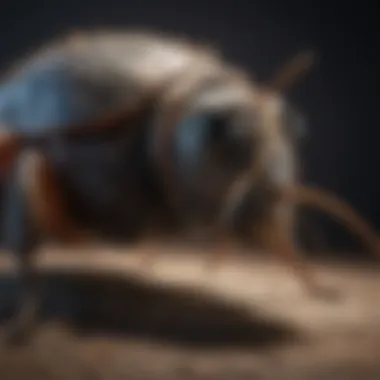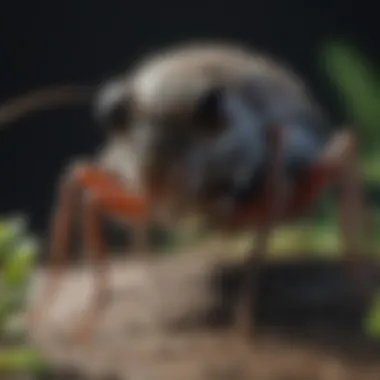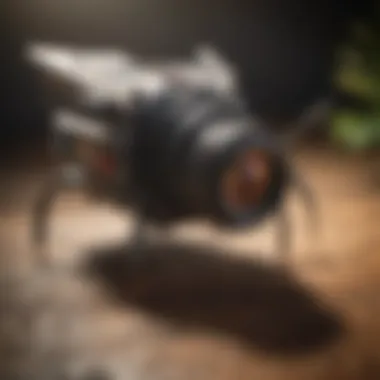Understanding the XT 2000: Advanced Pest Control Insights


Intro
The XT 2000 serves as a pivotal advancement in the field of pest control, particularly for handling termite infestations. Understanding its features and applications is essential not only for pest control professionals but also for homeowners seeking effective solutions. This section begins with pest identification, which is critical for recognizing termite problems.
Pest Identification
Detailed descriptions of common pests
Termites have several species that vary in behavior and habitat. The most common species include the Subterranean termite, which lives underground and typically causes significant structural damage. The Drywood termite infests dry wood, primarily seen in attics and wooden frames. The Dampwood termite prefers moist, decayed wood and is often found in areas with high humidity.
Signs and symptoms of infestations
Recognizing a termite invasion early can save significant costs and effort. Common signs include:
- Mud tubes: Narrow tunnels on exterior walls, indicating subterranean activity.
- Wood damage: Hollow-sounding wood or noticeable galleries indicating feeding.
- Discarded wings: Swarmers shed wings near windows or doors.
- Frass: Wood-colored pellets resembling sawdust around infested wood.
These symptoms are vital for identifying pest issues, guiding the necessity for tools such as the XT 2000.
Prevention Strategies
Home maintenance tips for pest prevention
Preventive measures are the first line of defense against termites and other pests. Key strategies include:
- Sealing cracks: Examine the foundation and exterior walls for cracks and seal them.
- Proper drainage: Ensure gutters and downspouts direct water away from home.
- Wood maintenance: Treat wooden structures with preservative products.
Natural deterrents and barriers
Natural solutions also aid in pest prevention. Some effective options are:
- Cedar oil: A natural repellent, particularly against termites.
- Boric acid: Used as a pesticide, boric acid can deter pests when applied correctly.
- Physical barriers: Installing metal mesh or concrete barriers to prevent entry.
Treatment Options
Overview of chemical vs. natural treatments
When infestations occur, choosing the right treatment method is crucial. The XT 2000 can assist with both chemical and natural options.
- Chemical treatments: Involve specialized insecticides that target termites. These can be effective but require careful application.
- Natural treatments: Include methods like bait stations or the use of nematodes that target pest larvae, offering a less toxic approach.
Step-by-step guides for DIY treatments
For those opting to manage pests on their own, following these steps can be beneficial:
- Identify the type of termite: Use the signs previously mentioned for accurate identification.
- Choose a treatment: Decide between chemical or natural treatments based on the severity of the problem.
- Prepare the treatment area: Clear vegetation and debris to access affected structures.
- Apply the treatment: Follow instructions for the specific product. Ensure safety measures are adhered to.
- Monitor progress: Regularly inspect the area for signs of continued activity.
The XT 2000 enhances the pest control process by providing advanced features, tailored solutions, and supporting both professionals and DIY enthusiasts in tackling termite issues effectively.
Foreword to the XT
The XT 2000 represents a significant advancement in pest control technology, particularly targeting termite management. This section aims to underscore the relevance of the XT 2000 within the broader context of pest control, spotlighting its innovative features and practical applications. By exploring its definition, importance, and integration into modern pest management strategies, the subsequent discussions will provide clarity on why the XT 2000 is becoming an essential tool for homeowners, professionals, and DIY enthusiasts alike.
Definition and Overview
The XT 2000 is a state-of-the-art pest control device, expertly designed to detect and address termite infestations. This machine utilizes advanced sensing technologies to provide accurate detections, allowing for timely interventions. Its design integrates robustness and user-friendliness, making it accessible for both professionals and non-experts. Understanding its core features enables users to appreciate its significance in the ongoing battle against pests.
Importance in Pest Control
In pest control, especially concerning termite management, effective detection is crucial. Termites often cause considerable damage before their presence is even noted. The XT 2000 plays a vital role in preventing such scenarios. It not only streamlines the detection process but also informs users of the potential severity of an infestation. Moreover, this technology contributes to cost savings in pest management. By addressing infestations early, users can avoid expensive repairs associated with termite damage.
"Reliable pest detection is the first step in effective pest management. With the XT 2000, timely actions become more feasible."
Understanding the XT 2000’s capabilities equips users with the knowledge to protect their properties effectively. As pests evolve, so must our methods of control, making technologies like the XT 2000 critical to modern pest management strategies.
Technical Specifications


Technical specifications play a pivotal role in understanding the capabilities and limitations of the XT 2000 in pest control. These specifications detail the device's design, performance metrics, and operational efficiency, giving users a framework to evaluate its effectiveness in combating unwanted pests, especially termites. Understanding these specifications helps homeowners and professionals make informed decisions regarding investments in pest control technology, ensuring that they choose solutions relevant to their specific needs.
Design and Build Quality
The design and build quality of the XT 2000 are essential to its usability and durability. This device is engineered with an ergonomic design, making it easy for users to handle, even during prolonged operation. The materials used are resilient, providing durability against the rigors of outdoor environments where pests often thrive. A standout feature is the compact size, which allows for easy storage and portability, enhancing the convenience for individuals who may need to transport the device.
Furthermore, the XT 2000 is built with robustness in mind. It is resistant to moisture and unfavorable weather conditions, making it reliable for both indoor and outdoor applications. Users have noted that this durability contributes significantly to the overall cost-effectiveness of the device, as it requires fewer replacements and repairs over its lifespan.
Functional Capabilities
Functional capabilities are where the XT 2000 really shines. Equipped with advanced sensors, it offers precise detection of termites. This technology allows for early detection, which is crucial in preventing extensive damage to properties. The device operates seamlessly in a variety of settings, catering to both residential and commercial applications.
The XT 2000 also features variable sensitivity settings, allowing users to adjust the detection parameters based on the specific infestation level. This adaptability is particularly beneficial in diverse environments, where pest behavior may vary. Additionally, the integration of data logging capabilities enables users to track and analyze pest activity over time, providing valuable insights for future pest management strategies.
In summary, the technical specifications of the XT 2000 highlight how its design, build quality, and functional capabilities collectively enhance its performance in pest control. As technology continues to develop, understanding these specifications equips users with the knowledge necessary to leverage the full potential of devices like the XT 2000, ensuring more effective and efficient pest management solutions.
Operating Principles of the XT
Understanding the operating principles of the XT 2000 is crucial for appreciating its role in modern pest control. This section discusses how the device works, delving into the specific methods it utilizes for pest detection and management. Comprehending these principles is essential for homeowners, as they highlight the technology's efficacy and align expectations with performance.
Mechanism of Action
The Mechanism of Action of the XT 2000 revolves around advanced sensing techniques and smart analysis. This device employs a combination of field sensors and AI-driven algorithms to detect the presence of termites.
- Field Sensors: These sensors are positioned strategically around the property. They constantly monitor the environment for signs of termite activity. When termites approach, these sensors pick up their movements and vibrations.
- AI Algorithms: Once the sensors register activity, the data is transmitted to the device's onboard AI system. This system processes the information, analyzing patterns that could indicate a termite infestation.
The advantage of this mechanism is its proactive nature. The XT 2000 does not wait for visible signs of an infestation. Instead, it provides early warnings, enabling timely intervention. This can save significant cost and effort compared to traditional pest control methods, which often react only after damage has occurred.
Technology Behind the XT
The Technology Behind the XT 2000 is rooted in the fusion of hardware and software designed to enhance pest control efficiency.
- Wireless Communications: The device utilizes wireless technology allowing seamless data transfer. It can alert users through a smartphone app whenever it detects termite activity.
- Data Analytics: The system doesn't merely record activity; it analyzes trends over time. This feature helps users understand potential hot spots or areas of concern, allowing for targeted interventions rather than generalized treatments.
- Energy Efficiency: Built to be energy-efficient, the device ensures that it can operate for extended periods without frequent battery replacement, which enhances user experience and minimizes inconvenience.
The XT 2000’s integration of cutting-edge technology allows it to serve not just as a detector but as a proactive barrier against termites. Its design can fundamentally change how homeowners approach pest control.
In summary, the operating principles of the XT 2000 encapsulate a mix of innovative technology and practical application designed to meet modern pest control needs. By utilizing advanced sensing and intelligent analysis, the device positions itself as a pivotal tool for those serious about protecting their homes from termite damage.
Applications of the XT
The applications of the XT 2000 are extensive and critical in the domain of pest control technology. Understanding these applications provides valuable insights for homeowners and professionals alike. This advanced system is tailored for efficient management, particularly in termite detection and eradication. Its precise application ensures that pest control methods are effective and environment-friendly, addressing the increasing concerns about pesticide use.
As pest problems grow more complex with shifts in climate and urban development, the XT 2000 offers tailored solutions for specific environments. This makes it not only a practical choice but also a forward-thinking one in pest management strategies.
Residential Use Cases
In a residential setting, homeowners often face challenges with pests that can damage property and compromise safety. The XT 2000 excels in this arena, providing numerous advantages.
- Termite Detection: This device features advanced sensors and can detect even the most minuscule signs of termite activity. It prevents structural damage by identifying issues early on.
- User-Friendly Interface: Homeowners appreciate the intuitive design. It allows easy monitoring and control without requiring extensive technical knowledge.
- Cost-Effective Treatment: Investing in the XT 2000 can be more economical compared to frequent treatments with traditional methods.
- Minimal Environmental Impact: With its precision targeting, the device reduces unnecessary pesticide use, which benefits both the environment and human health.
The overall benefit of using the XT 2000 in residential applications lies in its ability to provide peace of mind to homeowners worried about pests. They can now actively manage risks and protect their investments.
Commercial Applications
The commercial sector also sees effective use of the XT 2000. Businesses must maintain their premises to avoid pest-related disruptions that affect operations and reputation.
- Industrial Facilities: The XT 2000 is ideal for large industrial buildings, where such equipment can cover extensive areas. Its detection precision helps prevent infestations from escalating.
- Food and Beverage Industry: Strict regulations on pest control in food safety make the XT 2000 essential. It ensures compliance by monitoring pest activity proactively.
- Hospitality Sector: Hotels and restaurants can mitigate potential pest complaints by investing in this technology. It enhances customer satisfaction through an ensured pest-free environment.
- Cost Savings Over Time: The long-term savings from preventing pest infestations can be substantial for businesses. This device reduces the need for emergency extermination services that are often costlier.
The application of the XT 2000 in commercial settings exemplifies a strategic investment in maintaining health standards and business integrity.
Utilizing the XT 2000 in both residential and commercial contexts reveals its significance in addressing contemporary pest challenges. Its features address specific needs while ensuring a more measured approach to pest management. Both homeowners and business operators benefit from its efficiency and effectiveness.
Advantages of Using the XT
Understanding the advantages of using the XT 2000 is essential for homeowners and pest control professionals alike. This advanced technology offers numerous benefits in the realm of pest management, specifically in efficiently dealing with termite issues. The following sections detail the critical aspects of the XT 2000's functionality, focusing on its efficiency in termite detection and long-term cost-effectiveness.
Efficiency in Termite Detection


The XT 2000 stands out for its precision in termite detection. Traditional pest control methods often rely on visual inspections or chemical treatments. These methods may not identify the true extent of an infestation. In contrast, the XT 2000 uses advanced sensors and algorithms to locate termites that are otherwise hard to see.
- Speed: The device can instantly identify the presence of termites, reducing the need for extensive manual inspections.
- Accuracy: It pinpoints infestations with high accuracy, minimizing the risk of overlooking affected areas.
- Real-time Data: The XT 2000 provides immediate feedback, allowing for quicker response times in treatment applications.
The effectiveness of the XT 2000 in detecting termites ultimately leads to an expedited response. Homeowners can address problems before they escalate, potentially saving thousands in repair costs associated with extensive termite damage.
Cost-Effectiveness Over Time
Investing in the XT 2000 can lead to significant savings over time. Initially, the device may seem costly; however, when one considers the long-term benefits, it becomes clear that it offers great value.
- Reduced Chemical Use: By accurately detecting termites early, the XT 2000 lessens the need for widespread chemical treatments.
- Lower Repair Costs: Early detection means less damage, which translates to lower repair costs in the future.
- Durability and Reliability: The XT 2000 is designed for long-term use. This reliability decreases the frequency of replacements compared to lesser technology.
When comparing the cost of investment against the potential long-term savings, the XT 2000 presents a compelling case for homeowners looking to manage pest control efficiently.
"Early detection with the XT 2000 not only protects your home but also your wallet."
Limitations of the XT
The XT 2000 presents an interesting solution to pest control, but it is crucial to understand its limitations. No technology is without faults, and acknowledging these can help potential users make informed decisions. When evaluating the XT 2000, two primary limitations stand out: its initial investment costs and potential maintenance issues. These aspects are essential, as they influence not only the adoption of this technology but also its long-term viability.
Initial Investment Costs
Investing in the XT 2000 requires consideration of its purchase price. This price can be significantly higher than traditional pest control methods. Many homeowners might hesitate to allocate a substantial budget for a product that they may not fully understand or trust. The XT 2000 is designed to provide advanced features, but the initial outlay can be a barrier for many.
Some aspects to consider regarding investment costs include:
- Purchase Price: The cost of the XT 2000 may vary based on the model and features selected.
- Financing Options: Some retailers offer payment plans, which can make the initial cost more manageable.
- Comparative Analysis: Potential buyers should compare the total cost with traditional solutions or newer pests control technologies.
While the XT 2000 may promise superior efficiency and efficacy, potential buyers must weigh the upfront costs against the anticipated benefits. In many cases, users may find that the long-term savings in pest control costs justify the initial investment.
Potential Maintenance Issues
Another challenge with the XT 2000 lies in its maintenance requirements. All high-tech devices require some level of upkeep, and the XT 2000 is no exception. Failure to maintain the device can lead to decreased efficiency or even failure to function. Users should be aware of the ongoing costs and efforts required to keep it in optimal condition.
Key considerations regarding maintenance include:
- Regular Inspections: Users need to inspect the device periodically to ensure it operates correctly.
- Technical Support: Not all areas may have professional support available to service the XT 2000, which can be a concern for users.
- Replacement Parts: If the device requires any replacements, obtaining genuine parts could be tricky or time-consuming.
"Understanding the limitations of a technology is as important as knowing its capabilities. The XT 2000 may be powerful, but be prepared for the compromises involved."
In summary, recognizing the initial investment and ongoing maintenance requirements is essential in assessing the XT 2000. While the technology adds great value to pest control methods, users must also prepare for the associated costs and responsibilities.
Comparison with Other Pest Control Technologies
The comparison of the XT 2000 with other pest control technologies is critical for homeowners and pest control professionals alike. Understanding how the XT 2000 stacks up against both traditional methods and newer systems allows for informed choices in pest management strategies. This section highlights various aspects that readers must consider, enhancing their knowledge to deal effectively with pest issues.
XT vs. Traditional Methods
Traditional pest control methods often rely on chemical treatments and physical barriers. These can range from sprays to baits, which, while sometimes effective, tend to have significant drawbacks.
Efficiency: The XT 2000 offers superior efficiency in termite detection. Traditional methods may require extensive groundwork and can miss hidden infestations. In contrast, the XT 2000 utilizes advanced sensors to quickly identify termite activity in hidden areas, minimizing property damage over time.
Safety: Homeowners often express concerns about chemical exposure. The XT 2000 operates with minimal use of harmful chemicals, reducing risks for families and pets. Traditional methods may involve hazardous substances that pose a health risk long after treatment.
Cost: While the initial outlay for the XT 2000 may seem high, its ongoing maintenance costs can be lower than regular chemical applications needed for traditional pest control. This can offer long-term savings, making it a more cost-effective solution.
Environmental Impact: The XT 2000 is designed to be less intrusive environmentally than many traditional methods. Its focus on minimal chemical usage helps protect local ecosystems, while traditional solutions often lead to negative effects on wildlife.
The effectiveness of the XT 2000 in comparison to traditional methods presents a compelling case for its adoption among households. By leveraging modern technology, it allows for both a practical and sustainable approach to pest management.
XT vs. Emerging Technologies
The pest control landscape is continuously evolving, with emerging technologies also aiming to tackle infestations more effectively. Comparing the XT 2000 with these new solutions provides insight into its potential future relevance.
Integration with Smart Home Systems: Emerging technologies often include smart capabilities. The XT 2000, however, stands out due to its dedicated function in termite management. Many smart pests control systems focus broadly on various insects and may not target specific issues as effectively.
Data-Driven Approaches: New technologies are adopting AI and machine learning to predict infestations based on historical data. While the XT 2000 does not currently incorporate these advanced analytics, its established detection capabilities could integrate well with future data-driven tools.


User Experience: The XT 2000 offers a straightforward user interface that requires minimal training. Emerging technologies may introduce complex systems needing significant user input for operation, which can deter less tech-savvy homeowners.
Cost versus Value: While some emerging solutions may appear cheaper upfront, they often come with hidden costs or additional subscriptions. The XT 2000 is built as a standalone tool that focuses on delivering value over time.
"The XT 2000’s approach utilizes current methods while still aiming for higher efficiency and long-term security against pests, setting it apart from both traditional and emerging technologies."
In sum, comparing the XT 2000 with traditional methods and emerging technologies sheds light on its efficient, cost-effective, and environmentally friendly advantages. Homeowners can make smarter decisions in pest management by understanding these dynamics.
User Feedback and Case Studies
User feedback plays a critical role in assessing the effectiveness and reliability of the XT 2000 in real-world scenarios. By examining the experiences of homeowners and pest control professionals, we gain insight into the performance of the device. Case studies also provide a deeper understanding of its practical applications and user satisfaction. This section highlights the importance of collecting user experiences and case studies that elucidate the functionality and impact of the XT 2000 in pest management.
Homeowners’ Perspectives
Homeowners often serve as the first line of feedback when evaluating a pest control technology like the XT 2000. Many have noted its efficiency, particularly in detecting and managing termite infestations. When faced with an issue, many of these individuals turned to online forums and social media platforms like Reddit and the Facebook community for opinions. They shared stories of how the XT 2000 provided peace of mind, knowing they could effectively monitor and address potential pest problems before they escalated.
Feedback about features such as ease of use and setup time were commonly praised. Homeowners appreciated the intuitive interface that simplifies operation. This is particularly vital for those who may not have extensive technical skills. The lightweight design was also a frequent highlight, making it easy to store and transport.
Homeowners' testimonials often emphasized the value they obtained from their investment. Many reported that the device helped them save money by reducing the need for expensive, ongoing pest control services. Overall, the user experiences outlined the XT 2000's role in transforming termite management within residential settings, empowering homeowners to take charge of their pest control needs.
Professional Insights
On the other hand, professional pest control experts have provided a wealth of insights regarding the XT 2000. They offer a more technical perspective, focusing on reliability and effectiveness in comparison to other pest control solutions available in the market. According to professionals, the XT 2000 stands out for its advanced technology and methodologies, which facilitate precise detection of termites.
Many professionals have noted the device's ability to reduce time spent on inspections significantly. This efficiency enables them to focus on mitigation rather than just detection. Furthermore, the data collected by the XT 2000 can assist in decision-making, ensuring that treatment strategies are tailored to a specific infestation's needs. This data-driven approach adds a layer of professionalism in pest management.
Another frequent point of feedback from experts is the device's adaptability. Professionals appreciate how it fits into various approaches to pest management, from traditional to modern integrated pest management strategies. This versatility is crucial for maintaining a competitive edge in an evolving industry.
"The XT 2000 represents a shift in how we approach pest management. Its blend of technology and practical applications supports both homeowners and allowing us to operate more effectively."
In summary, the case studies and feedback from both homeowners and professionals reveal a positive reception around the XT 2000. Homeowners value its usability and cost-effectiveness, while professionals recognize its technological advantages. This convergence of insights illustrates the XT 2000’s vital role in pest control.
Future of Pest Control with XT
The trajectory of pest control technology is continuously evolving, and the XT 2000 plays a pivotal role in leading this transformation. As issues related to pest management become increasingly complex, technological solutions like the XT 2000 are not only enhancing pest control efficacy but also offering new prospects for users. Homeowners and pest management professionals must understand the implications of these advancements to leverage them effectively.
Anticipated Technological Advancements
In the coming years, several technological advancements related to the XT 2000 can be predicted. One significant area of development is machine learning algorithms. These algorithms can analyze pest behavior and create targeted strategies for elimination. This means that the XT 2000 may become more adaptive, continually improving its effectiveness based on accumulated data.
Integration with smart home technology is another anticipated advancement. Imagine controlling the XT 2000 through a mobile app or system that sends alerts when pest activity is detected. This syncs with broader home automation systems, allowing for real-time responses to pest threats.
Additionally, advancements in sensor technology can enhance the detection capabilities of the XT 2000. More sensitive sensors will allow for early pest identification, enabling proactive measures before infestations become more severe. This aspect underscores a critical change in pest management—moving from reactive to proactive strategies.
Potential Market Trends
The market dynamics of pest control technology are changing in parallel with the advancement of devices like the XT 2000. Increasingly, there is a noticeable shift toward environmentally friendly solutions. Homeowners are more aware of the ecological impact of pest control methods, and many prefer solutions that mitigate chemical use while remaining effective. The XT 2000 aligns with this trend, providing options that are less harmful to the environment.
Additionally, we may observe a rise in DIY pest control products as users become more educated about technologies like the XT 2000. The availability of user-friendly models will empower homeowners to take control of pest management, leading to a growing market for self-service pest control solutions.
The integration of public awareness about health risks posed by pests will further influence market trends. Consumers are increasingly seeking products that not only eliminate pests but also ensure a healthier living environment. Thus, the XT 2000's applications could expand beyond just pest elimination to include broader health-conscious solutions, potentially impacting its market reach.
The future of pest control does not rely only on technology but also on the understanding and involvement of homeowners, ensuring they are prepared for upcoming innovations in the pest management landscape.
In summary, the future of pest control with the XT 2000 is promising, marked by technological advancements and an evolving market that increasingly values efficiency and environmental responsibility.
Closure
In concluding this exploration of the XT 2000, it becomes apparent that this technology is reshaping pest control on multiple levels. Firstly, the multifaceted nature of the XT 2000 encompasses not only its efficient functionality but also its adaptability in various settings. Homeowners, property managers, and pest control professionals alike can glean significant benefits from understanding its operational framework.
Summary of Key Points
- Advanced Functionalities: The XT 2000 employs precision detection techniques that heighten efficacy in termite management.
- Diverse Applications: This technology is applicable in both residential and commercial spaces, making it versatile for different user needs.
- Economical Advantage: While initial investment might seem significant, the long-term cost-effectiveness must not be overlooked. Investments yield savings through effective management and reduced extermination costs.
- User Perspectives: Insights from both homeowners and professionals show a positive trend towards the adoption of the XT 2000.
- Future Prospects: Anticipated advancements promise to further enhance its capabilities, positioning it as a key player in pest control technology.
Final Thoughts on the XT in Pest Management
The XT 2000 not only represents a leap forward in pest control strategies but also heralds a new era of informed management decisions. As pests like termites become smarter and more resilient, the ability to adapt with technology such as the XT 2000 is paramount.
Choosing to implement this tool reflects a proactive rather than a reactive approach to pest issues. It encourages homeowners to engage actively with pest management, enhancing safety and reducing risks associated with traditional pest control methods. As we continue to witness trends that lean towards smarter, green technologies, the XT 2000 is positioned to remain highly relevant.
"Investing in the XT 2000 is not just a step towards immediate pest control but a commitment to sustaining an effective, long-term management strategy."
Ultimately, the XT 2000 stands as a testament to the evolution in pest management technology, constantly challenging outdated methods and enhancing the user experience for homeowners and professionals.



